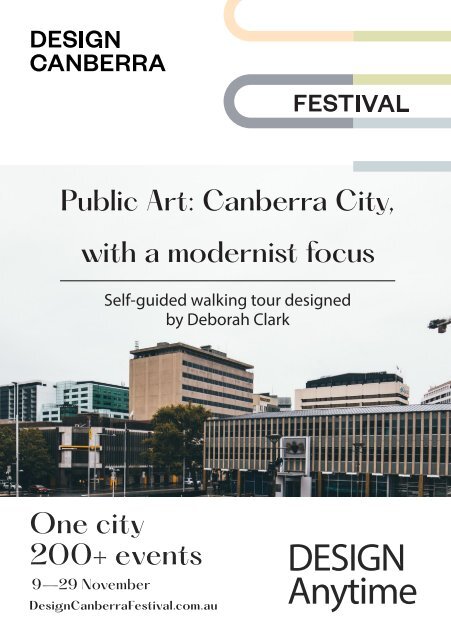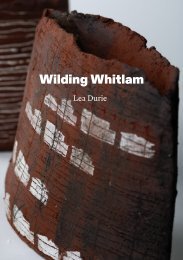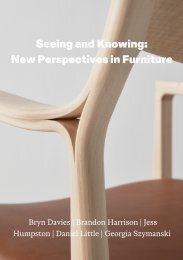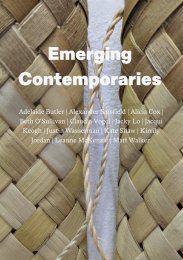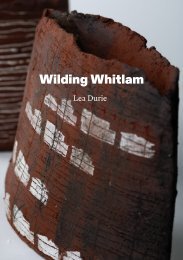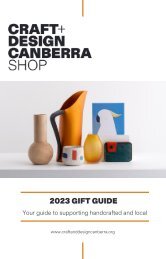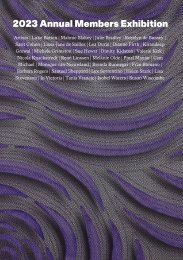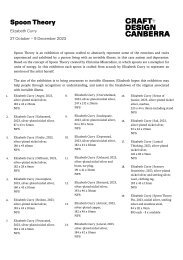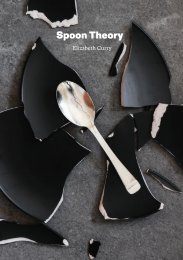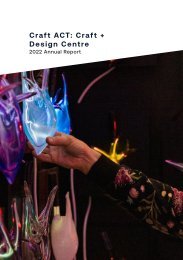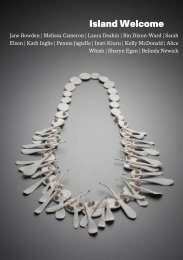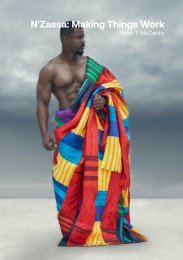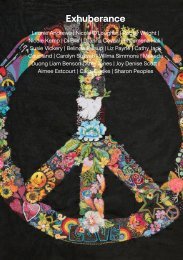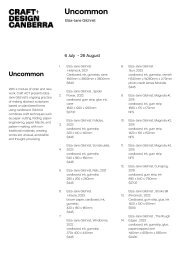Public Art Stroll: Canberra City
To connect with audiences who cannot physically make it to Canberra during the festival, DESIGN Canberra is curating a DESIGN Anytime program. This new program includes self-guided tours of iconic architecture and contemporary design throughout Canberra. This will promote and celebrate Canberra as a global city of design every day of the year. This walking tour of public art begins in Civic Square on London Circuit and ends in Knowles Place on London Circuit on the other side of City Hill.
To connect with audiences who cannot physically make it to Canberra during the festival, DESIGN Canberra is curating a DESIGN Anytime program. This new program includes self-guided tours of iconic architecture and contemporary design throughout Canberra. This will promote and celebrate Canberra as a global city of design every day of the year.
This walking tour of public art begins in Civic Square on London Circuit and ends in Knowles Place on London Circuit on the other side of City Hill.
You also want an ePaper? Increase the reach of your titles
YUMPU automatically turns print PDFs into web optimized ePapers that Google loves.
<strong>Public</strong> <strong>Art</strong>: <strong>Canberra</strong> <strong>City</strong>,<br />
with a modernist focus<br />
Self-guided walking tour designed<br />
by Deborah Clark<br />
One city<br />
200+ events<br />
9—29 November<br />
Design<strong>Canberra</strong>Festival.com.au<br />
DESIGN<br />
Anytime
Introduction<br />
DESIGN <strong>Canberra</strong> celebrates and promotes<br />
<strong>Canberra</strong> as a global city of design. It is an<br />
annual festival that has been running seven<br />
years strong.<br />
The festival is presented by Craft ACT: Craft + Design Centre, a respected<br />
and nearly 50-year-old membership organisation which represents the<br />
<strong>Canberra</strong> region’s designers, artists and craftspeople at every stage of<br />
their careers. Craft ACT is home to a community of glass artists, furniture<br />
makers, textiles artists, ceramic artists and jewellers, and collaborates<br />
with designers and architects across many disciplines.<br />
CANBERRA<br />
DESIGN<br />
FESTIVAL<br />
Front cover: <strong>Canberra</strong> <strong>City</strong>.<br />
Photo: 5 Foot Photography.<br />
Back cover: Petrie Plaza.<br />
Photo: Craft ACT.<br />
Deborah Clark walking tour.<br />
Photo: 5 Foot Photography.<br />
2
H1<br />
Heading<br />
H2 Heading<br />
Quote –“It was the biggest job ever built in<br />
Australia at the time – a million square feet – it<br />
was a city not a building! And I’m much more<br />
interested in the building as part of the city,<br />
in the urban forms of things, than I am in the<br />
individual gem.”<br />
3<br />
The self-guided tour<br />
To connect with audiences who cannot physically<br />
make it to <strong>Canberra</strong> during the festival, DESIGN<br />
<strong>Canberra</strong> is curating Body – a Design DESIGN <strong>Canberra</strong> Anytime celebrates program. and promotes <strong>Canberra</strong><br />
This new program as a includes global city self-guided of design. tours It is an of annual iconic program that has<br />
architecture and been contemporary running six design years strong. throughout The festival is presented by<br />
<strong>Canberra</strong>. This Craft will promote ACT: Craft and + celebrate Design Centre, <strong>Canberra</strong> a respected as and nearly<br />
a global city of 50-year- design every old membership day of the year. organisation which represents the<br />
<strong>Canberra</strong> region’s designers, artists and craftspeople at every<br />
This walking tour of public art begins in Ainslie Place,<br />
stage of their careers. Craft ACT is home to a community<br />
goes to <strong>City</strong> Walk, Petrie Plaza and Garema Place, and<br />
of glass artists, furniture makers, textiles artists, ceramic<br />
follows London Circuit around to Knowles Place on the<br />
artists and jewellers, and collaborates with designers and<br />
other side of <strong>City</strong> Hill. It will take around 45 minutes to<br />
architectsacross many disciplines.<br />
an hour.<br />
Access. Body –Access details
Travel Route<br />
Deborah Clark is an art historian who has had an<br />
extensive professional engagement with the visual<br />
arts in <strong>Canberra</strong>, where she has been a curator,<br />
editor, writer, lecturer, and active member of the arts<br />
community for 30 years. Deborah has an enduring<br />
interest in the art, architecture and urban fabric of<br />
<strong>Canberra</strong>. Join her on this self-guided version of her<br />
walking tours.<br />
The walk explores <strong>Canberra</strong> <strong>City</strong>.<br />
4
1. ‘Untitled’(1981)<br />
2. ‘ACT Memorial’ (2006)<br />
3. ‘The <strong>Canberra</strong> Times fountain’ (1979)<br />
4. ‘The other side of midnight’ (2012)<br />
5. ‘Star ceiling’ (1963)<br />
6. ‘Icarus series’ (2009)<br />
7. ‘Civic Carousel’ (c.1914)<br />
8. ‘Bush pack’ (2011)<br />
9. ‘The big little man’ (1999)<br />
10. ‘Eternity’(1981)<br />
11. ‘Dream lens for the future’ (2012)<br />
12. ‘Gravity circle’ (1981)<br />
13. ‘Dreaming’ (1964)
S MARITTI,<br />
‘Untitled’<br />
1967<br />
ten relief panels, copper coated concrete;<br />
subsequently painted<br />
These panels are integrated into the façade of the<br />
building and designed to complement the architecture.<br />
In their abstracted form of rhythmic grids, suggesting<br />
the dynamism of modern life they are a perfect foil to the<br />
bank building, one of the numerous cool internationalist<br />
1960s constructions that defined <strong>Canberra</strong>’s new civic and<br />
commercial heart. The artist is otherwise unknown and it is<br />
thought that s/he may have been the builder.<br />
LOCATION. Corner of London Circuit and Ainslie<br />
Place, Commonwealth Bank Building facade<br />
‘Untitled’. Photo: Craft ACT.
Matthew HARDING,<br />
‘ACT Memorial’<br />
2006<br />
stainless steel rods, bluestone basalt, glass and<br />
lighting<br />
This work was designed to commemorate people who<br />
have served Australia in war, conflict, peacekeeping and<br />
humanitarian missions and who have an association with<br />
the ACT. The design of the memorial is reminiscent of<br />
the Vietnam Memorial on Anzac Parade in describing a<br />
space for reflection rather than a monument, with 2 semicircular<br />
curtains of steel rods spiralling up to meet each<br />
other forming a kind of sculptural ‘teepee’; at its centre<br />
a sphere – or globe – etched with the words ‘Courage,<br />
Loyalty and Mateship’.<br />
Harding was a prolific sculptor in many mediums and is<br />
represented by 8 works of art in the city and Acton (some<br />
in collaboration with other artists, and including the<br />
stainless steel Cushion in Garema Place and the bronze<br />
Casuarina pods on <strong>City</strong> Walk), plus a number in <strong>Canberra</strong><br />
suburbs.<br />
The material – stainless steel rods – and form of this work<br />
is an evident and elegant nod to and echo of the <strong>Canberra</strong><br />
Times fountain with which it lines up in perfect symmetry.<br />
The records of those honoured by the memorial are at:<br />
www.memorial.act.gov.au/<br />
Commissioned by the ACT Government.<br />
LOCATION. Ainslie Place, at London Circuit end<br />
‘ACT Memorial’. Photo: Craft ACT.
10 10
Robert<br />
WOODWARD,<br />
‘The <strong>Canberra</strong><br />
Times fountain’<br />
1979<br />
stainless steel tubes and rods<br />
Woodward was trained as an architect and became known<br />
as an innovative sculptor of many well-known fountains<br />
including the ‘El Alamein Memorial Fountain’ (1961, Kings<br />
Cross, Sydney), the ‘NSW Parliament House Courtyard<br />
Fountain’ (1983), and several major works in <strong>Canberra</strong>:<br />
the ‘High Court Forecourt Fountain and cascade’ (1980),<br />
the ‘Australian Parliament House fountain’ (1988) and, in<br />
collaboration with the artist Ante Dabro (and Lester Firth<br />
& Associates), the water component of Dabro’s ‘Royal<br />
Australian Navy Memorial’ (1986) on Anzac Parade. (He was<br />
commissioned by the Australian War Memorial to design a<br />
stepped granite ‘Cascade’ at the northern end of the Pool of<br />
Reflection in 1980, which was replaced in 1988 by an eternal<br />
flame.) Woodward received the national Walter Burley Griffin<br />
Award for Urban Design in 1991.<br />
Gift of Federal Capital Press, commissioned 1976.<br />
LOCATION. <strong>City</strong> Walk and Ainslie Place/Ainslie Avenue axis<br />
11 ‘The <strong>Canberra</strong> Times fountain’. Photo: Craft ACT.
Anne ROSS,<br />
‘The other side of<br />
midnight’<br />
2012<br />
bronze, stainless steel<br />
The artist imagined this trio of a doll/child and 2<br />
carousel dogs apparently in the act of fleeing a<br />
carousel as ‘linking closely with the much loved Civic<br />
Carousel’.<br />
Commissioned by artsACT.<br />
LOCATION. <strong>City</strong> Walk and Ainslie Place/Ainslie Avenue<br />
‘The other side of midnight’. Photo: Craft ACT.
Frank HINDER,<br />
‘Star ceiling’<br />
1963<br />
glass mosaic ceiling<br />
Look up! This entrance was originally the entrance<br />
to Monaro Mall, the first three-storey covered<br />
shopping mall in Australia, designed by Whitehead<br />
and Payne, and opened by Prime Minister Robert<br />
Menzies in 1963. Created as part of the building,<br />
the vaulted tiled ceiling is a remarkable blend of<br />
form, tone and colour, and perhaps the most subtle<br />
work of art in the city centre. It’s also a testament to<br />
the significance of art in <strong>Canberra</strong> life and the sense<br />
of modernity that the city encapsulated. Margel<br />
Hinder, the artist of the marvellous aluminium<br />
‘Sculptured form’ (1970) in ‘Woden Town Square’<br />
(1970) and Frank’s wife, was commissioned to<br />
make one of her kinetic sculptures for Monaro<br />
Mall, Revolving sphere 1963, which was suspended<br />
above the escalators, but is now sadly lost.<br />
LOCATION. Entrance to David Jones from <strong>City</strong> Walk<br />
‘Monaro Mall’. Photo: Bronwen Jones.
Jan BROWN,<br />
‘Icarus series’<br />
2009<br />
bronze [scaled up from original small ciment<br />
fondu works from 2004 & 2005 - 06, in<br />
the collection of the <strong>Canberra</strong> Museum and<br />
Gallery]<br />
Jan Brown has been one of <strong>Canberra</strong>’s most<br />
significant figures in the arts since her arrival here<br />
in 1956, as an artist, teacher – at the ANU School<br />
of <strong>Art</strong> and its precursors – and advocate for<br />
Territory support of artists. Her art has focussed<br />
on the natural world, in particular birds, whom<br />
she has often imbued with human characteristics<br />
and follies. With the ‘Icarus 1-4 series’ she merged<br />
bird and human in her treatment of the Greek<br />
myth of Daedalus and his son Icarus; the father<br />
created wings from feathers and wax to allow<br />
them to escape captivity on the island of Crete,<br />
but Icarus flew too near the sun, the wax melted<br />
and he fell into the sea. Another major work by<br />
Brown is the bronze ‘Kangaroos’ (1979-80) in<br />
Commonwealth Park.<br />
Commissioned by artsACT.<br />
LOCATION. Petrie Plaza, near <strong>City</strong> Walk intersection<br />
‘Icarus’ series. Photo: Craft ACT.
Herbert THOMSON,<br />
‘Civic Carousel’<br />
c. 1914<br />
The ‘Civic Carousel’ was originally located at the St<br />
Kilda Esplanade in Melbourne where it commenced<br />
operation in 1914. It was designed and built by<br />
engineer Herbert Thomson, also the designer of<br />
Australia’s first successful steam motor car. At the time<br />
it was described as the largest portable steam riding<br />
gallery and the first made in Australia. The organ, fiftytwo<br />
hand-carved wooden horses and two elephants<br />
were imported from Germany, and the twisted brass<br />
uprights from Scotland. The outside of the carousel<br />
roof is adorned with paintings of horses, elephants<br />
and tigers in the wilderness, whilst paintings inside the<br />
merry go round feature more contemplative scenes.<br />
The ‘Civic Carousel’ is listed on the ACT Heritage<br />
Objects Register.<br />
Purchased NCDC 1973.<br />
LOCATION. Petrie Plaza and <strong>City</strong> Walk intersection<br />
‘Civic Carousel’. Photo: Craft ACT.
Amanda STUART,<br />
‘Bush pack (nil<br />
tenure)’<br />
2011<br />
bronze<br />
This work is a pack of seven bronze dogs in three<br />
groups, that appear to be coursing through <strong>City</strong><br />
Walk in the direction of the Civic Carousel. The<br />
work is human/canine in scale. Stuart’s practice is<br />
embedded in issues around landscape and fauna,<br />
in particular the conflicted relationship between<br />
humans and wild dogs. The artist made the originals<br />
of these works in impermanent materials – fabric,<br />
wrapped like bandages – and the bronzes are cast<br />
from those original works. Currently this work is a<br />
little invisible as the pack has been broken up by<br />
newly installed garden beds; apparently there is a<br />
possibility the work will be relocated.<br />
Commissioned artsACT.<br />
LOCATION. <strong>City</strong> Walk, between Petrie Plaza and Garema Place<br />
‘Bush pack (nil tenure)’. Photo: Craft ACT.
Dean BOWEN,<br />
‘The big little man’<br />
1999, acquired 2008<br />
bronze<br />
Commissioned artsACT.<br />
LOCATION. Petrie Plaza, between city Walk and London Circuit<br />
‘The big little man’. Photo: Craft ACT.
John ROBINSON,<br />
‘Eternity’<br />
1981<br />
polished bronze and stainless steel, painted<br />
Robinson was originally a sculptor of figurative works,<br />
in particular children, athletes and acrobats, including<br />
works for the Australian Institute of Sport (1980s).<br />
In the 1970s he embarked on a series of abstract<br />
sculptures intended to symbolise universal human<br />
values and dynamic processes, many incorporating<br />
scientific theories and concepts. ‘Eternity’ represents<br />
the artist’s faith in the future of the human race, its<br />
ring form suggesting something continuous and<br />
unbroken.<br />
LOCATION. Petrie Plaza, between <strong>City</strong> Walk and London Circuit.<br />
‘Eternity’. Photo: Craft ACT.
Keizo USHIO,<br />
‘Dream lens for<br />
the future’<br />
2012<br />
granite<br />
Ushio’s signature style of sculpture is this form,<br />
a ring or loop, which is created by carving<br />
intertwining ribbons of stone and threedimensional<br />
circles, works of interlocking parts.<br />
The techniques employed are notoriously difficult<br />
with the material of granite, which has significant<br />
weight and density, yet the artist’s achievement is<br />
a work of elegance and lightness. Ushio employs<br />
mathematics in the engineering of his works,<br />
specifically the Moebius strip, which is a one-sided,<br />
one-edged surface. The placement of Dream lens<br />
is intended to frame <strong>City</strong> Hill and Parliament House<br />
beyond, a view visible only from the median strip.<br />
Purchased by artsACT.<br />
LOCATION. On northside of the median strip, Northbourne Avenue<br />
‘Dream lens for the future’. Photo: Craft ACT.
Haryuki UCHIDA,<br />
‘Gravity circle’<br />
2007<br />
stainless steel, magnet, paint<br />
Uchida is a Japanese artist whose work has been shown<br />
in Sculpture by the Sea. His work is kinetic, incorporating<br />
movement, and he often uses magnets to create<br />
illusionary effects. The forms in the work combine to<br />
suggest balance, energy and poise; the large central<br />
element balances across a narrow edge and references<br />
the scales of justice – the fine-tuning and careful focus<br />
required in weighing evidence and delivering fairness in<br />
the judicial process.<br />
Commissioned by artsACT.<br />
LOCATION. ACT Magistrates Court<br />
‘Gravity circle’. Photo: Craft ACT.
Milan VOJSK,<br />
‘Dreaming’<br />
1964, installed 1973<br />
cast bronze figure on natural rock in<br />
rectangular pool<br />
Vojsk was an established artist when he migrated<br />
to Australia in 1957 and settled in Sydney. This<br />
work was commissioned by the Reserve Bank<br />
and donated to the city of <strong>Canberra</strong>, reflecting<br />
the influence of Dr H C ‘Nugget’ Coombs who<br />
believed in that institution’s commitment to and<br />
engagement with the urban fabric of the city and<br />
the community that lives and works here. The title<br />
is a reference to Australian Indigenous culture,<br />
as well as a central tenet of the artist’s belief<br />
in the natural, spiritual and moral order of the<br />
universe. Its style is grounded in early twentiethcentury<br />
expressionist sculpture, particularly the<br />
work of artists such as Ernst Barlach and Wilhelm<br />
Lehmbruck. The work sits on a natural rock in what<br />
was originally a pool, with a fountain. Sadly in<br />
recent years it has not been maintained.<br />
Commissioned by the Reserve Bank of Australia and<br />
gifted to the city of <strong>Canberra</strong>.<br />
LOCATION. Knowles Place<br />
‘Dreaming’. Photo: Craft ACT.
PROUDLY PRESENTED BY<br />
GOVERNMENT PARTNERS<br />
Craft ACT Craft and Design Centre is<br />
supported by the ACT Government, the Visual<br />
<strong>Art</strong>s and Craft Strategy - an initiative of the<br />
Australian, State and Territory Governments,<br />
and the Australia Council for the <strong>Art</strong>s - the<br />
Australian Governments arts funding and<br />
advisory body.<br />
PLATINUM PARTNERS<br />
HOTEL PARTNER


